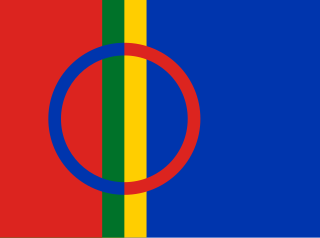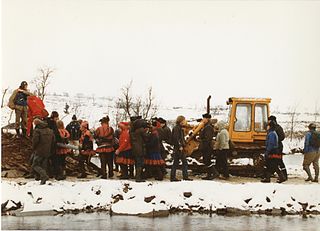
The Sámi are the traditionally Sámi-speaking Indigenous peoples inhabiting the region of Sápmi, which today encompasses large northern parts of Norway, Sweden, Finland, and of the Kola Peninsula in Russia. The region of Sápmi was formerly known as Lapland, and the Sámi have historically been known in English as Lapps or Laplanders, but these terms are regarded as offensive by the Sámi, who prefer their own endonym, e.g. Northern Sámi Sápmi. Their traditional languages are the Sámi languages, which are classified as a branch of the Uralic language family.

Sápmi is the cultural region traditionally inhabited by the Sámi people. Sápmi includes the northern parts of Fennoscandia, also known as the "Cap of the North".

Finnmark is a county in the northern part of Norway.

The Sámi flag is the flag of Sápmi and the Sámi people, one of the Indigenous people groups of the Nordic countries and the Kola Peninsula of the Russian Federation.

Kvens are a Balto-Finnic ethnic minority in Norway. Kvens are indigenous to the northern regions of Norway, Sweden, Finland and parts of Russia. In 1996, Kvens were granted minority status in Norway, and in 2005 the Kven language was recognized as a minority language in Norway.
Indigenous land rights are the rights of Indigenous peoples to land and natural resources therein, either individually or collectively, mostly in colonised countries. Land and resource-related rights are of fundamental importance to Indigenous peoples for a range of reasons, including: the religious significance of the land, self-determination, identity, and economic factors. Land is a major economic asset, and in some Indigenous societies, using natural resources of earth and sea form the basis of their household economy, so the demand for ownership derives from the need to ensure their access to these resources. Land can also be an important instrument of inheritance or a symbol of social status. In many Indigenous societies, such as among the many Aboriginal Australian peoples, the land is an essential part of their spirituality and belief systems.

The Alta conflict or Alta controversy was a series of protests in Norway in the late 1970s and early 1980s concerning the construction of a hydroelectric power plant in the Alta River in Finnmark, Northern Norway.

The Sámi Parliament of Norway is the representative body for people of Sámi heritage in Norway. It acts as an institution of cultural autonomy for the Sami people of Norway.
Hålogalandsallmenningen is the proposed name for the organization which is expected to manage about 50% of the land and inland water resources in the counties of Troms and Nordland in Norway. It expected that the members in the board of directors will be elected from the County Council of Troms, the County Council of Norland, and the Sami Parliament of Norway. A similar organization, the Finnmark Estate, is already established in the county of Finnmark.
Indigenous rights are those rights that exist in recognition of the specific condition of indigenous peoples. This includes not only the most basic human rights of physical survival and integrity, but also the rights over their land, language, religion, and other elements of cultural heritage that are a part of their existence and identity as a people. This can be used as an expression for advocacy of social organizations, or form a part of the national law in establishing the relation between a government and the right of self-determination among its indigenous people, or in international law as a protection against violation of indigenous rights by actions of governments or groups of private interests.

The Norwegianization of the Sámi was an official policy carried out by the Norwegian government directed at the Sámi people and later the Kven people of northern Norway, in which the goal was to assimilate non-Norwegian-speaking native populations into an ethnically and culturally uniform Norwegian population.
Sámi institutional symbols are of relatively new origin, as the Sámi political institutions themselves are quite new. The symbols generally draw inspiration from old ornamental traditions such as duodji and the "runes" of the traditional shaman's drums. The symbols generally don't follow the rules of tincture, as the "Sámi colours" are traditionally placed colour on colour.
Sámi politics refers to politics that concern the Sámi ethnic group in Norway, Sweden, Finland and Russia. In a more narrow sense, it has come to indicate the government of Sámi affairs by Sámi political institutions. This article deals with Sámi political structures, with an emphasis on the contemporary institutions.
In Australia, Indigenous land rights or Aboriginal land rights are the rights and interests in land of Aboriginal Australians and Torres Strait Islander people; the term may also include the struggle for those rights. Connection to the land and waters is vital in Australian Aboriginal culture and to that of Torres Strait Islander people, and there has been a long battle to gain legal and moral recognition of ownership of the lands and waters occupied by the many peoples prior to colonisation of Australia starting in 1788, and the annexation of the Torres Strait Islands by the colony of Queensland in the 1870s.

The Recognition of Native American sacred sites in the United States could be described as "specific, discrete, narrowly delineated location on Federal land that is identified by an Indian tribe, or Indian individual determined to be an appropriately authoritative representative of an Indian religion, as sacred by virtue of its established religious significance to, or ceremonial use by, an Indian religion". The sacred places are believed to "have their own 'spiritual properties and significance'". Ultimately, Indigenous peoples who practice their religion at a particular site, they hold a special and sacred attachment to that land sacred land.

The Indigenous Peoples' Rights Act of 1997 (IPRA), officially designated as Republic Act No. 8371, is a Philippine law that recognizes and promotes the rights of indigenous cultural communities and Indigenous peoples in the Philippines.
Ancestral domain or ancestral lands are the lands, territories and resources of indigenous peoples, particularly in the Asia-Pacific region. The term differs from indigenous land rights, Aboriginal title or Native Title by directly indicating relationship to land based on ancestry, while domain indicates relationships beyond material lands and territories, including spiritual and cultural aspects that may not be acknowledged in land titles and legal doctrine about trading ownership.

Laila Susanne Vars is a Norwegian-Sami human rights lawyer and former politician. Elected rector of Sámi University of Applied Sciences 2019-2023. First Sámi woman to achieve a PhD in Law. She is former research director at the Norwegian National Human Rights Institution (NHRI). Expert member of the United Nations' Expert Mechanism on the Rights of Indigenous Peoples (EMRIP) 2017-2023.
Human rights in Norway protect the fundamental rights of all persons within the Kingdom of Norway. These rights are safeguarded by Chapter E of the Constitution of Norway or Kongeriket Norges Grunnlov, as well as the ratification of various international treaties facilitated by the United Nations. The country maintains a dedicated commitment to human rights and was the second country to ratify the European Convention on Human Rights.
Nordkalottfolket is a Sámi political party in Norway. It was first established in 2005 and contested the 2005 election as the Finnmark List, but was renamed in 2009 to its current name. The NKF has been led by Arne Kristian Vestre since 2022.








